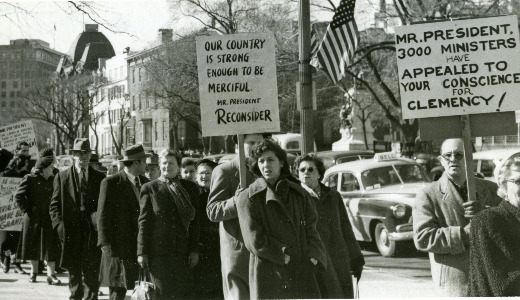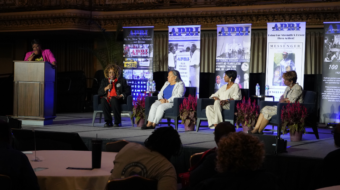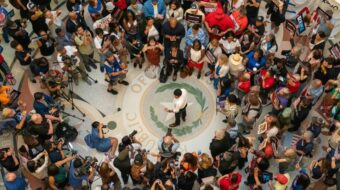
Book Review
“Exoneration: The Trial of Julius and Ethel Rosenberg and Morton Sobell – Prosecutorial deceptions, suborned perjuries, anti-Semitism, and precedent for today’s unconstitutional trials”
By Emily Arnow Alman and David Alman.
2010, Green Elms Press, paperback, 471 pages, $24.95
Julius and Ethel Rosenberg, parents of two young children, were executed by the U.S. government on June 19,1953. But the case has refused to die.
“Exoneration” is to my knowledge the first book on the Rosenberg-Sobell case published since Morton Sobell told The New York Times in 2008 that he and Julius Rosenberg had given non-atomic classified information to the Soviet Union in 1944-45, having to do with radar and other defense technology. That was during World War II, when the U.S. and the Soviet Union were allies in the fight against fascism.
Contrary to the implication of the headline the Times chose to put on its report (“Figure in Rosenberg Case Admits Spying for Soviet Union”), Sobell emphasized that neither he nor, as far as he knew, either of the Rosenbergs had committed the atom spying “crime” for which the couple was tried in 1951 and sent to the electric chair, and for which he served 18 years of a 30-year jail sentence.
In fact, the essential truth that Sobell’s interview revealed was that the Rosenbergs “didn’t do the thing they were being killed for,” as their son Robert Meeropol told the Times.
The fraudulent nature of the case centered, the Almans show, on the prosecution’s transposition of the time of the crime from World War II to the Cold War.
The authors write, “The defendants had not actually been prosecuted for conspiring to pass information to a wartime ally in 1944-1945. Their formal indictment described the conspiracy as lasting from 1944-1950, but the last alleged espionage act listed in the indictment was in 1945. The chronological facts were ignored and the formal indictment was replaced by an oral indictment in the courtroom in which the crime was described as having been committed during the Cold War years, at a time when fear of a Soviet atom bomb attack was widespread” – a fear that was propagated by the Cold Warriors themselves.
“The prosecution did not point to any criminal acts committed by the defendants after the Allied victory in 1945,” the authors note. Prosecutors “repeatedly described the actions as having been committed on behalf of an enemy nation. The jurors believed the defendants were being tried for committing treasonable acts on behalf of an enemy, and found them guilty of treason.”
Meanwhile, the book shows, U.S. Cold Warriors were engaged in “The Great Turnabout,” concealing the extent of German espionage in the U.S. and making ex-Nazis our new (and in some cases old) best friends in the war against Communism. The authors detail how some of the most famous names of U.S. capitalism – such as DuPont, Ford, General Motors and Standard Oil (later Exxon) – gave material aid to the Nazis. General Motors, for example, manufactured military planes for the Nazis throughout the war at its Opel plant in Germany. Yet these companies’ CEOs were never tried for treason. And after the war, the U.S. rushed to get convicted Nazi leaders released from jail so as not to antagonize our important new ally, West Germany.
“Exoneration” is, I believe, also the first book published on the case since the 2008 release of grand jury transcripts which showed, among other things, that the “evidence” that was used to convict and electrocute Ethel Rosenberg was false, and deliberately so.
The authors were co-founders and leaders of the National Committee to Secure Justice in the Rosenberg Case, which later became the National Committee to Reopen the Rosenberg Case.
The book tells two major stories.
One, it sheds new light on the case itself. Presenting a careful analysis of the voluminous trial record, grand jury testimonies, and other documents and evidence that have come to public light in recent years, it lays out clear evidence of shocking, deliberate misconduct by the prosecution, judge, and top U.S. officials, all the way to the attorney general and chief justice of the Supreme Court – including collusion, deception, manipulation of evidence and suborned perjury.
Two, it presents a first-hand account of the movement to save the lives of the Rosenbergs. What began as a small group of people in New York who in 1951 formed the Committee to Secure Justice in the Rosenberg Case became a national and international movement of millions, including figures like Albert Einstein, Pablo Picasso, and the Pope.
In the dark days of the McCarthy period, Rosenberg committees sprang up in every major American city. Thousands of letters and postcards were sent to Washington calling for a new trial and for clemency.
Beginning in December 1952 and continuing until the execution six months later, a 24-hour vigil in front of the White House, appealing for clemency for the Rosenbergs, was maintained by thousands of Americans, some on their lunch hours or after work, others traveling there from far away.
On the day of the execution, some 12,000 to 24,000 mourners overflowed the funeral hall in New York. The Fur Workers Union provided a 24-hour honor guard for the caskets.
At the height of McCarthyism? How was this possible?
The authors recount a problematic relationship between the committee and the U.S. Communist Party. They relate how early on they had assumed that the CPUSA was providing funds for the Rosenbergs’ lawyer, Emanuel Bloch, and were surprised to learn that was not the case. They indicate that the party was “utterly opposed” to the formation of the committee. Later, they relate several incidents in which party leaders met with committee members and urged the disbanding of the committee or curtailing of its activities. They cite an FBI memo reporting that party leader Gus Hall, at the time in jail along with Sobell, criticized some of the committee’s efforts. The concern expressed, the authors note, was that the committee’s activities would be branded as “Communist” and at the same time hurt the Communist Party, which was battling police-state type repression and was of course the real target of the Rosenberg case in the first place – the effort to label the party, individual Communists and “sympathizers,” labor unions, anti-lynching organizations, immigrant support groups, and the like as “un-American,” traitors and spies. Read more on the context here.
Yet it is clear from the authors’ narrative of the remarkable history of the committee and the massive movement to save the lives of the Rosenbergs that Communists played an enormous role in the growth of the committee and the movement as a whole.
This was a time of fear and confusion, just a few years after a terrifying new atomic weapon first appeared on the world scene. Hindsight suggests that party leaders, in initially distancing themselves from the Rosenbergs and the committee, sometimes in harsh and cruel ways, made some grievous mistakes. But their primary responsibility as they certainly must have seen it then was to protect the party, on behalf of the entire American progressive movement, in the face of overwhelming government terror. Who would like to have been in their shoes?
Even as the party’s leaders were being indicted and jailed across the country, with many leaders and activists going “underground,” in a wave of anti-Communist terror, Communists who had led the mass union and civil rights drives of the 1930s and ’40s continued their activities for social justice alongside of non-Communists, including in the movement to save the Rosenbergs, in what surely was an example of courage and principle. Historian Norman Markowitz comments, “Would the defense campaign have existed at the level that it did both here and internationally without the CPUSA? The answer is no.” (For more on the Rosenberg case and the political setting, see Markowitz’s 2008 article in Political Affairs.)
This is a topic which merits further consideration. Hopefully some historian will produce an account of the Communist Party’s role, warts and all, in battling McCarthyism.
As this book makes evident, the witch-hunters could not kill the American progressive movement. The mass movement to save the Rosenbergs was the forerunner of the great civil rights movement that was already sprouting, and of the other transformative movements that would soon emerge.
The authors emphasize the role of anti-Semitism in the Rosenberg-Sobell case. It was clearly a big factor. But like racism, anti-Semitism is not simply a thing in itself – it is a tool used to accomplish other aims. I think the authors make a mistake by comparing the Rosenberg trial to trials with heavy anti-Semitic aspects in the Soviet Union and Czechoslovakia in 1952. It essentially lets off the hook the Cold Warriors at the highest levels of the U.S. who conducted the Rosenberg case in order to destroy the American Communist-progressive movement. Strikingly, the timeline at the front of the book notes that the Soviet government in 1955 exonerated those executed in1952, and the Czech government did likewise in 1963.
The United States has yet to come to terms with the truth about the crimes committed in the persecution and execution of the Rosenbergs. “Exoneration” provides a compelling picture of what those crimes in high places were, and why they matter to us today. Hopefully, it will help bring closer the day when our government exonerates Julius and Ethel Rosenberg.
Photo: Washington, D.C., White House vigil for clemency for the Rosenbergs, February 1953. (Courtesy of the Daily Worker/Daily World Photographs Collection at the Tamiment Library/Robert F. Wagner Labor Archives, New York University)










